The AMD Radeon R9 290 Review
by Ryan Smith on November 5, 2013 12:01 AM EST- Posted in
- GPUs
- AMD
- Radeon
- Hawaii
- Radeon 200
Power, Temperature, & Noise
As always, last but not least is our look at power, temperature, and noise. Next to price and performance of course, these are some of the most important aspects of a GPU, due in large part to the impact of noise. All things considered, a loud card is undesirable unless there’s a sufficiently good reason – or sufficiently good performance – to ignore the noise.
As we alluded to in our look at the 290’s build quality and AMD’s last minute specification change, while the 290 has great performance under the complete range of our gaming benchmarks, it’s with power, temperature, and noise that it has to pay the piper for that performance. There’s no getting around the fact that 47% on the 290 series reference cooler is going to be loud, and in this section we’ll break down those numbers and attempt to explain why that is.
First, let’s start with voltages. Ideally we’d use VIDs here, but due to the fact that none of our regular tools can read AMD’s VIDs for the 290 series, we’re left with what works. And what works is GPU-Z, which can read the VDDC coming off of the IR 3567B controller. These aren’t “perfect” numbers as we don’t have the ability to factor out fluctuations due to temperature or the impact of vDroop, but they’ll work in a pinch.
| Radeon R9 290 Series Voltages (VDDC/GPU-Z) | ||||
| Ref. 290X Boost Voltage | Ref. 290 Boost Voltage | Ref. 290 Base Voltage | ||
| 1.11v | 1.18v | 1.14v | ||
To that end you can immediately see that the 290 starts off in a weakened position relative to the 290X. Second tier products are a mixed bag in this regard as sometimes they’ll be composed solely of chips with damaged functional units that can be shut off and then downclocked to operate at a lower voltage, while in other cases they’ll also include chips that have worse leakage and power consumption characteristics. In the case of the 290 we have the latter.
As such the 290 is operating at a higher voltage than the 290X at both the base GPU clockspeed of 662Mhz, and the boost GPU clockspeed of 947MHz. This means at any given clockspeed the GPU on the 290 is going to be drawing more power – likely more than enough to offset the reduction from the disabled CUs – and furthermore we’re seeing that the voltage reduction from operating at lower voltages is not very significant. If these results are reasonably accurate then this means that the power costs of ramping up the clockspeed are relatively cheap, but the power savings of throttling down are relatively sparse. The GTX Titan, by comparison, sees a full 100mv decrease going from 940MHz to 836Mhz.
Having established that, we can see why AMD’s 7% fan speed increase had such a large impact on performance. Even a bit more cooling allows the card to jump to far higher clockspeeds, which significantly improves performance. With a fan speed of 47% the 290 has enough cooling to sustain 947MHz across everything except the TDP limited FurMark and Company of Heroes 2.
| Radeon R9 290 Average Clockspeeds | |||
| 47% Fan (New Default) | |||
| Boost Clock | 947MHz | ||
| Metro: LL |
947MHz
|
||
| CoH2 |
930MHz
|
||
| Bioshock |
947MHz
|
||
| Battlefield 3 |
947MHz
|
||
| Crysis 3 |
947MHz
|
||
| Crysis: Warhead |
947MHz
|
||
| TW: Rome 2 |
947MHz
|
||
| Hitman |
947MHz
|
||
| GRID 2 |
947MHz
|
||
With that out of the way, let’s dive into power, temperatures, and noise.
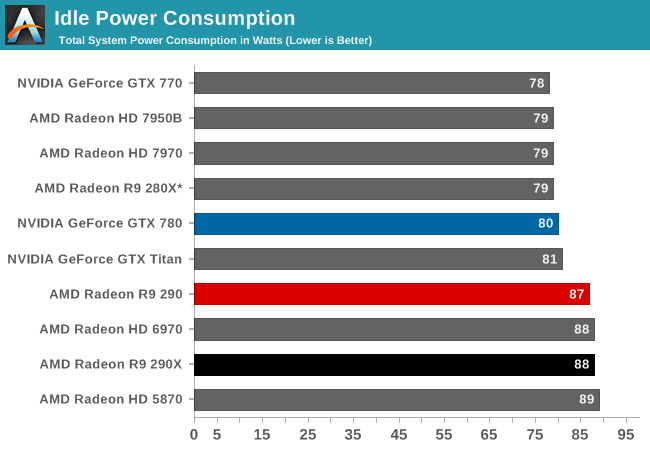
Idle power is essentially unchanged from the 290X. The 16 GDDR5 memory chips aren’t doing AMD any favors, but more significantly they appear to still have a power leak in their drivers at idle. Until they fix that, the 290 series will draw several watts more than any other modern single-GPU card.
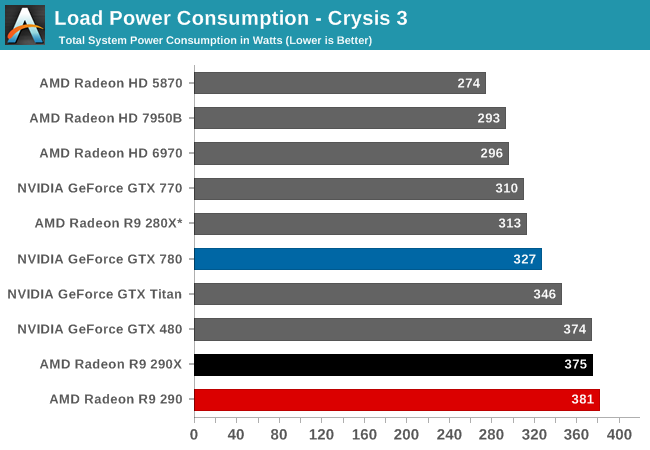
Moving on to power consumption under Crysis 3, we can see just how AMD’s TDP hasn’t changed compared to the 290X. In fact because these cards are effectively tied in performance in this game, we can even see at least some of the impact of the 290’s higher voltages. By operating at higher voltages in general, and then furthermore higher clockspeeds (requiring higher voltages), the 290 draws just a wee bit more power than the 290X under our gaming workload. Power efficiency wasn’t AMD’s strongest hand to behind with on 290X, and 290 makes it just a bit worse.
This also means that the 290 isn’t competitive with the GTX 780 on the matter of power consumption and power efficiency in general. A 54W difference at the wall for identical performance in Crysis 3 – or extrapolated over our complete benchmark suite a performance advantage of 6% – is very difficult to swallow. As with everything else to come for power, temp, and noise, the GTX 780 has a very real advantage here.
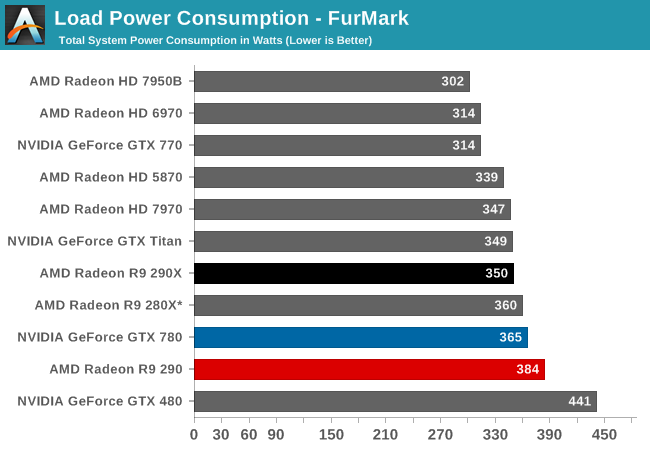
Moving on to FurMark, despite the fact that we should be TDP limited the 290 actually draws more power than the 290X. To be frank we’re at a bit of a loss on this one; 290 bottoms out at 662MHz here, so it may be that we’re seeing one of the things the card can do to try to maintain its base clockspeed. Alternatively this may be the voltage effect amplified. Regardless of the reason though it’s a very repeatable scenario, and it’s a scenario that has 290 drawing 34W more at the wall than 290X.
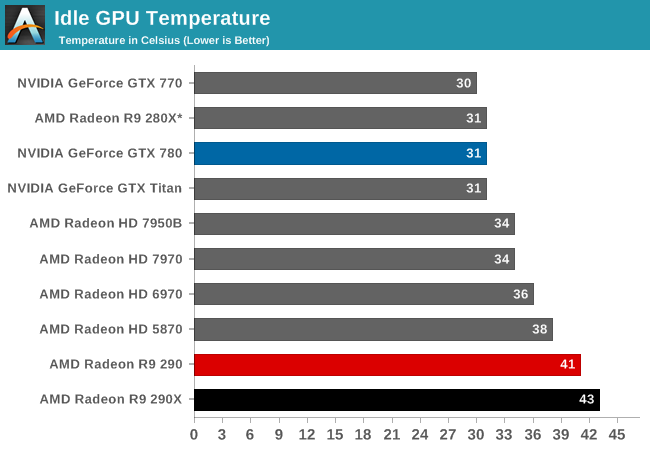
Given the fact that the 290 and 290X are built on identical boards, the idle temperatures are consistent, if not a bit more spread out than usual. Until AMD gets their power leak under control, Hawaii isn’t going to come down below 40C at idle with the reference cooler.
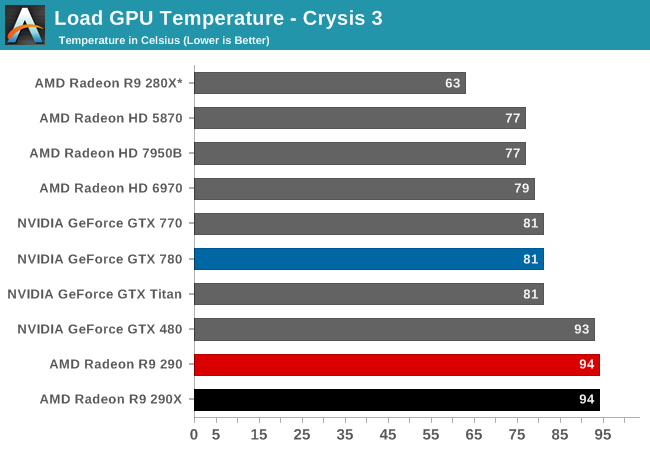
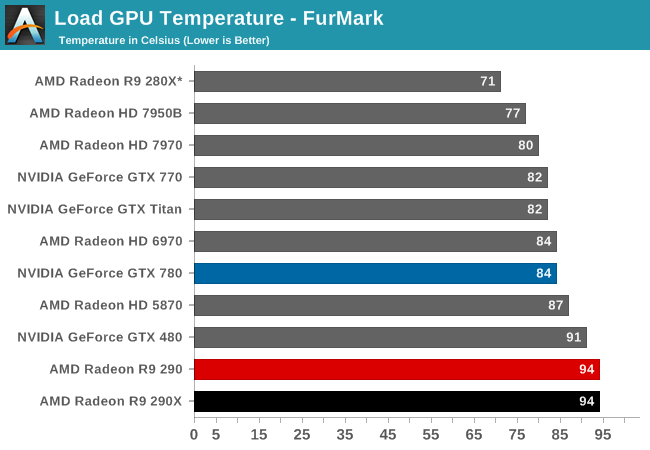
Due to the mechanisms of PowerTune on the 290 series, the sustained load temperatures for the 290 and 290X are a very consistent 94C. As we laid out in our review of the 290X these temperatures are not a problem so long as AMD properly accounts for them in their power consumption projections and longevity projections. But coming from earlier cards it does take some getting used to.
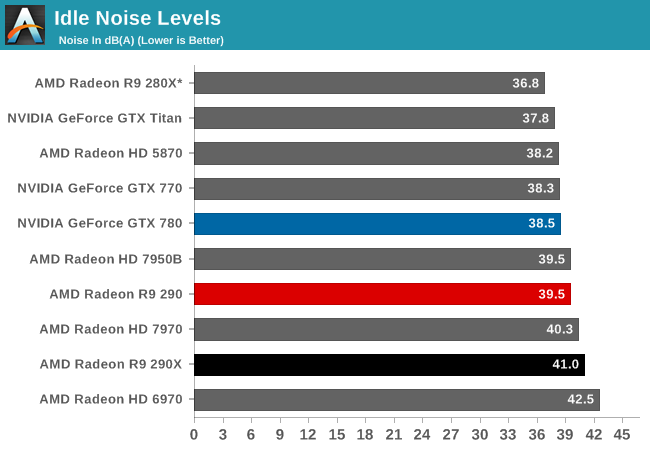
At last we have our look at noise. Starting with idle noise, we can see that the 290 actually outperforms the 290X to a meaningful degree, squeaking under the 40dB mark. The fact that these cards utilize the same cooler operating at the same fan speed means that these results caught us off guard at first, but our 290 sample for whatever reason seems to be slightly better built than our 290X sample. These results match what our ears say, which is that the 290X has a bit of a grind to it that’s not present on the 290, and consequently the 290 is that much quieter.
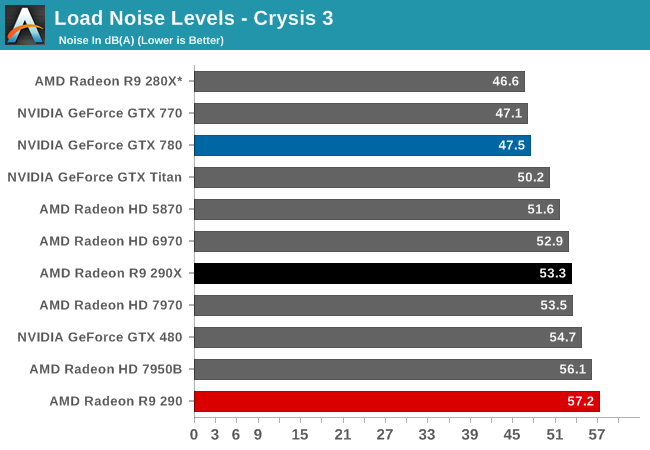
Our Crysis 3 noise chart is something that words almost don’t do justice for. It’s something that needs to be looked at and allowed to sink in for a moment.
With the 290 AMD has thrown out any kind of reasonable noise parameters, instead choosing to chase performance and price above everything else. As a result at 57.2dB the 290 is the loudest single-GPU card in our current collection of results. It’s louder than 290X (a card that was already at the limit for reasonable), it’s louder than the 7970 Boost (an odd card that operated at too high a voltage and thankfully never saw a retail reference release), and it’s 2.5dB louder than the GTX 480, the benchmark for loud cards. Even GTX 700 series SLI setups aren’t this loud, and that’s a pair of cards.
At the end of the day the 290 is 9.7dB louder than its intended competition, the GTX 780. With a 10dB difference representing a two-fold increase in noise on a human perceptual basis, the 290 is essentially twice as loud as the GTX 780. It’s $100 cheaper and 6% faster, but all of that comes at the very high price of twice the noise.
Everyone’s cutoff for a reasonable noise level for a single-GPU card is going to be different. Ours happens to be the 7970, which on our latest testbed measures in at 53.5dB. To that end the 290 is 3.7dB louder, putting it well past what we’d consider to be reasonable for the 290. It’s a powerful card, but these noise levels are unreasonable and unacceptable for any scenario that involves being able to hear the card while it’s working.
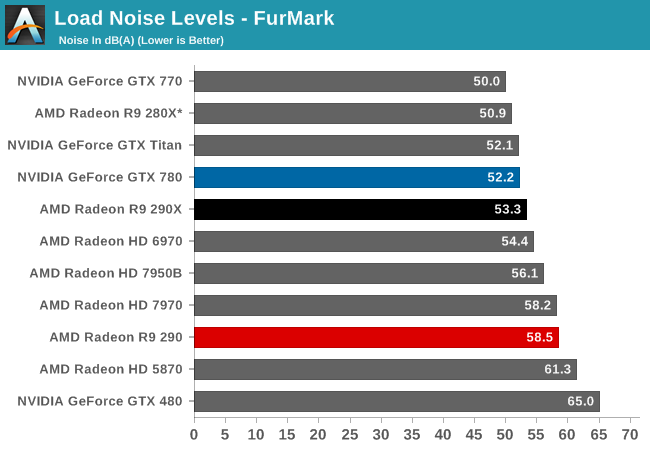
Finally we’ll look at noise under FurMark. As loud as the 290 is under Crysis 3, the 290 was only pushed to 45% fan speed under that workload. Under FurMark the 290 ratchets up to 47% and to its peak noise level of 58.5dB. Now to the credit of the 290 this does end up being better than the 5870 and GTX 480, but as neither of those cards implements modern power throttling technology it’s at best an unfair fight. Compared to any card with power throttling, the 290 ends up once more being the worst.
Wrapping things up, the power/temp/noise situation for the 290 is rather straightforward, but unfortunately for AMD it’s not going to be in their favor. 290 is at least marginally more power hungry and quite a bit louder than 290X, never mind GTX 780. As we’ve seen in previous pages the performance is quite good, but it comes at what will in most cases be a very high cost.
Finally, since we had a bit more time to prepare for the 290 review than we did the 290X review, we used part of our time to investigate something we didn’t get to do with the 290X: what would performance look like if we equalized for noise? Earlier in this article we took at brief look at performance if we equalized for noise against the 290X – the performance hit is about 12% - but how would the 290 fare if it were equalized to the GTX 780?
The answer is not well, likely for the voltage matters we discovered earlier in this article. To get a 290 down to ~48dB requires reducing the maximum fan speed to 34%, which is something AMD’s software allows. The problem is that at 34% the effective cooling level on the 290 is so poor that even after dropping to the base GPU clockspeed of 662MHz it still generates too much heat, requiring it to ramp up the fan speed to compensate. In other words it’s simply impossible to get the 290 to match the GTX 780’s noise levels under load. Based on our data the 290 requires a minimum fan speed of 38% to maintain its base clockspeed under sustained load, which pushes noise levels out from a GTX 780-like 48dB to a GTX Titan-like 50.9dB.
With that in mind, we went ahead and ran a selection of our benchmarks with the 34% maximum fan speed. The performance hit, as you’d expect, is significant.
| Radeon R9 290 Average Clockspeeds | |||||
| 47% Fan | 40% Fan | 34% Fan | |||
| Boost Clock | 947MHz | 947MHz | 947MHz | ||
| Metro: LL |
947MHz
|
830MHz
|
662MHz
|
||
| Battlefield 3 |
947MHz
|
870MHz
|
662MHz
|
||
| Crysis 3 |
947MHz
|
720MHz
|
662MHz
|
||
| Crysis: Warhead |
947MHz
|
662MHz
|
662MHz
|
||
| TW: Rome 2 |
947MHz
|
761MHz
|
662MHz
|
||
| GRID 2 |
947MHz
|
825MHz
|
700MHz
|
||

| Radeon R9 290 Relative Performance | ||||
| 290: 47% Fan Speed (Default) | 290: 40% Fan Speed | 290: ~34% Fan Speed | ||
| 100% | 88% | 78% | ||
To get down to the 34%-38% fan speed range, the 290 has to shed an average of 22% of its performance, peaking under a few titles at 25%. To be sure this makes the card much quieter – though not as quiet as a GTX 780 – but it also sacrifices much of the 290’s performance advantage in the process. At this point we’ve essentially reduced it to a 280X.
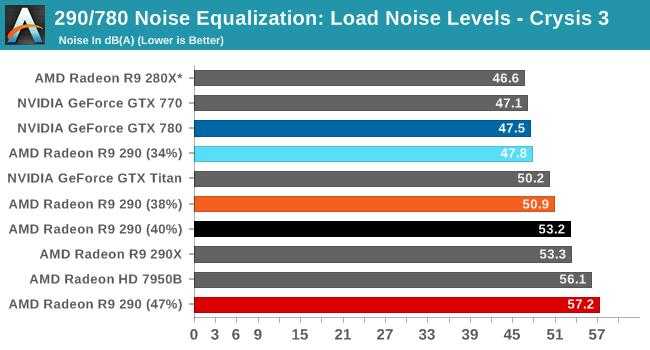
Looking at the resulting noise levels, you can see the full outcome of our tweaks. If we could sustain 34% we’d have a noise level consistently close to that of the GTX 780, but instead under Crysis 3 and a couple other games fan speeds level out at 38%, pushing noise levels to 50.9dB and placing them a bit higher than GTX Titan.
Based on this data it’s safe to say that the performance cost for using the fan control function to reduce the fan noise on the 290 will be moderate to severe. You can’t match GTX 780 or even GTX Titan, and doing so will reduce performance to that of a 280X. 40% on the other hand is more viable, but keep in mind we’re now at 290X noise levels for roughly 85% of the 290X’s performance, which isn’t a great outcome either.










295 Comments
View All Comments
HisDivineOrder - Tuesday, November 5, 2013 - link
Haha, spoken like someone who's never heard a card this loud. I can't wait to see all these cards on sale on ebay and forums everywhere. "I tried it and it's not for me, sidegrading to a 780," they'll say.This card is so loud you're going to be shocked by it. It's going to blow people's minds and it may even convert a few fanboys.
Finally - Tuesday, November 5, 2013 - link
If he buys one with a nice custom fan, there won't be anything left to complain about. Truly terrible outlook for an Nvidiot, isn't it?TheJian - Tuesday, November 5, 2013 - link
You're forgetting they are using ref NV also. You don't get that when you buy an NV card and they come overclocked on top of quiet. Also this thing will draw the same watts no matter what. It remains to be seen how good a different cooler will actually be. Did AMD really choose two terrible fans for their product launch? Seriously? I'm wondering how much they can really fix this situation. AMD had to know this would cause bad reviews about noise nearly everywhere and even on AMD loving sites. I can't believe they are completely dumb, and chose a total piece of junk for the fan/heatsink here. I really think people are putting to much faith in a fix with a fan change. They are at 95 all day basically, how much fan do you need to fix that?If NV runs their gpus at 95 tomorrow (and cranked up even more to meet the noise they're getting here) these cards will both be spanked. You get a better cooler on NV cards that are NOT ref also.
jnad32 - Tuesday, November 5, 2013 - link
The way I look at it, AMD is looking like an absolute genius. Everyone was ripping them on the 290X for it being too hot and too loud anyway. So instead of keeping the sound levels down they just went for what they do best, price/performance. They are now blowing every other card out of the water. There isn't a card on the planet that can touch this card in price/performance. Yea its loud as hell but, at least you have to think about it now just because of the price. What I really want to see is them unleash the 290X sound threshold and see what kind of raw numbers it can put up. Lets be honest, the only people who should buy reference cards are the ones who are putting water blocks on them.People have been saying this about the temp since launch, and I still don't get it. If AMD designed the chip to run at those temps, what's the big deal as long as it's not damaging it.
swing848 - Tuesday, November 5, 2013 - link
It will only get loud for me when playing games or the occasional benchmark. During games I wear headphones, and during benchmarks I can leave the room. I have a room dedicated to computer use and the house has good sound proofing, so, it will not bother other people.If I want it quiet I will use a water cooler with a large radiator and fan.
It is better than dumping all the hot air from the video card into my case, even if it is well cooled with 200mm fans. I overclock my CPU and I do not want it, RAM, or chips on the motherboard to get any hotter than necessary.
zeock9 - Tuesday, November 5, 2013 - link
The burning question on my mind at this point is why AMD is restricting board partners from releasing their own custom designed and obviously better performing coolers on this otherwise fantastic card?techkitsune - Tuesday, November 5, 2013 - link
They likely don't want to look bad.It's okay. It's tough doing thermal management. I cram 1,000w of LED into a 30mm x 30mm space. AMD doesn't have the cooling problems that I have. Nor does nVidia nor intel. They should be grateful. :D
HisDivineOrder - Tuesday, November 5, 2013 - link
They don't have them yet. That's why they haven't made custom boards. They're just getting them right now. They're going with what they have, which right now are just the reference boards. In a month or so, they'll have QA'ed some solutions with pre-existing cooling options, assuming said cooling options are good enough to benefit these cards.The thing is, you have to know these cards are running REALLY, REALLY hot to hit these levels at 95 degrees, so... custom coolers may have a hard time handling these cards without some tweaks. Perhaps to get faster fans on there.
Also, it takes time to redesign a board to add VRM's and the 290 and 290X are still very, very new. You're not going to get an MSI Lightning version overnight.
It's a solid deal in price, but man it's a shame AMD didn't offer a better custom cooler more attuned to the very special needs of the 290 series. It's also a shame their board is being pushed so hard and so much above what it seems capable of doing with reasonable power levels.
This is like the Bulldozer of GPU's.
techkitsune - Tuesday, November 5, 2013 - link
AMD could have just spent a few more dollars and used copper instead of aluminum, I would think. They could have easily doubled or tripled thermal conductivity and thus not needed to run the reference cooler anywhere near as high, plus that would leave a LOT of extra overclocking room.I still would buy it for the extra $45 that would have likely entailed, though I do worry about weight at that point. My 9800 GTX+ was pretty hefty, to say the least.
TheinsanegamerN - Tuesday, November 5, 2013 - link
THIS. why does amd, or heck, any manufacturer, insist on using aluminum fins on a 250 watt+ gpu? my old amd 2600xt had a full copper heatsink, and it was nowhere near as power hungry as this card (and it ran cool to boot. never over 47c).use the exact same heatsink, but make those fins copper. wonder how much lower the temps would go?